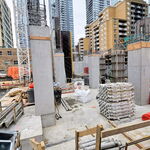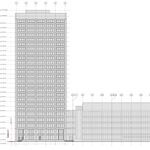Allandale25
Senior Member
And the Western Corridor is another living, breathing White Elephant.
You mean the Weston Corridor, right?
And the Western Corridor is another living, breathing White Elephant.
I caught myself using the term "Weston Corridor", and corrected myself some weeks back. Either term is actually misleading, I should use the 'Georgetown South' phrase, but it infers more than the segment I'm referring to.You mean the Weston Corridor, right?
Start doing your homework as its out there. There is no set date other than time frame when EMU and Tier 4 go into service.
The EMU time frame is going to be miss by a few years.
You can keep asking for something, but not going to happen.
As for your 3 trains for your service that takes 28 minutes from Bramalea and 53 from Mount Pleasant, you need 4 trains for 30 minute service, with Mount Pleasant being push to the point it may have to be something different.
Great points steve. And don't forget the extra 300 million for the tracks from Bramlea to Georgetown, just to get hourly service.I did, in fact I also looked up as to what's involved in a partial or total rebuild of an F59PH to Tier IV. Being done by a number of operators, and some California operators specialize in it. EMD even have a PDF on it. Whether that's cost-effective or not is a very real question, but you contradict the very point you attempt to make: "There is no set date other than time frame when EMU and Tier 4 go into service".
That might just be, to paraphrase you, why "doing my homework" showed no definitive answer. So as a stop-gap measure until the emus become available, that appears to be a very viable option to use them.
You overlook the present extant hourly service from Mt Pleasant in reaching that figure. It could well-be that the present day time service to Mt Pleasant could also be run by three coach consists. I've been on that run every other day past few weeks, it is *grossly under utilized* for even the six-coach consists.
Whether or not it would be worthwhile reconfiguring service on that segment of the corridor to do more runs, with less coaches, is the question, and what stock is available to do it. It certainly appears, from the very information you post, that there's going to be spare loco power.
Again, I propose examining "using what we have" to see if a more frequent and *supplementary to peak time trains* can be run on that corridor. As it stands, that corridor is woefully underutilized while even between rush-hours, the highways are jammed.
The sooner more regular service is run on that corridor, the sooner the intersecting bus connections can feed into it on a 15 min schedule.
Edit to Add: There's a greater issue at play here than just utilizing what Johnny Plebe has already paid for, and continues to pay for out of tax dollars.
When I viewed your pics of the *never ending* Burlington Boondoggle, I was jarred again at the massive amount of money spent on palaces, while Johnny Plebe has to view all of these incredibly expensive expanses while he can neither afford a home or car of his own. He wants to be able to hop on a bus, then hop on a train, and go downtown to work or do whatever. And the Western Corridor is another living, breathing White Elephant.
What is so wrong with trying to find ways, even if temporary, of utilizing spare stock to get that White Elephant moving down the tracks?
What's the deal here? Mr Plebe only gets to look at the train-set he's paid to buy, but not use?
It's time for Metrolinx to maximize the returns on investment. We saw this clearly with UPX, it was a an offer to the Gods of Conspicuous Consumption that Mr Plebe was initially financially forbidden from using. Thus the *fully justified* outrage.
UPX will never pay its way, so why the hesitation and obstinateness of finding ways to make the Corridor work, and make it work soon?
Start doing your homework as its out there. There is no set date other than time frame when EMU and Tier 4 go into service.
The EMU time frame is going to be miss by a few years.
You can keep asking for something, but not going to happen.
As for your 3 trains for your service that takes 28 minutes from Bramalea and 53 from Mount Pleasant, you need 4 trains for 30 minute service, with Mount Pleasant being push to the point it may have to be something different.
And don't forget the extra 300 million for the tracks from Bramlea to Georgetown, just to get hourly service.
Both excellent points, albeit Georgetown *might* be problematic due to the CN stretch still owned from Bramalea to Georgetown. From Bramalea south, with an added track, (almost already there) it should be a very low cost to start more frequent service.I just am looking forward to hourly all day and weekend service using the current bi-levels on Kitchener, Barrie and Stoufeville lines.
Me too.Honestly, at this point, I just am looking forward to hourly all day and weekend service using the current bi-levels on Kitchener, Barrie and Stoufeville lines.
I really think it will have to be Mount Pleasant - Union. And Barrie - Union and Mt Joy Union. They can do a through run Mount Plesant - Mt joy like with lake shore. And the Barrie can be the stand alone, or the through train with Richmond Hill or Milton. The Weston shuttle will feel like a short change to people in Brampton, and I won't blame them for feeling that way.Both excellent points, albeit Georgetown *might* be problematic due to the CN stretch still owned from Bramalea to Georgetown. From Bramalea south, with an added track, (almost already there) it should be a very low cost to start more frequent service.
Rob's point appears to be a separate issue, but they are closely related. The Bramalea south run (either to shuttle to Weston, or run through Union to Stouffville as an early form of SmartTrack) wouldn't initially break even. But that belies the purpose that follows. And perhaps a run is done alternately up the Richmond Hill line in lieu of Unionville/Stouffville? Or a shuttle from Scarborough Station north that synchs with the Lakeshore West service, grossly underutilized also that time of day. These would be feeders to the spines, in many cases.
The point remains: It appears we're at the point of having surplus loco and rolling stock. Rather than retire them because 'they're not shiny and new' when there's a pressing need to start using grossly underutilized corridors begs credulity.
Rob's stance underlines that of many: (if I may paraphrase) "Anything is better than nothing". Wasting perfectly usable infrastructure and stock is like a farmer claiming he doesn't want to harvest all of his crop because "the tractors are old and dirty".
For all day service between peak rush-hour, three car trains with older locos (and if the F59PHs were uprated to Tier IV, it would be at the loss of about 15% HP), not a problem at all for pulling power, they'd still have a greater power-to-weight ratio than the 10 or 12 car trains, let alone the 6 car ones with MP40s! Reliability? Probably less than the "brand new shiny locos", but it would still be more than good enough for daytime service. It's good enough for many US transit systems and Montreal, as if they're needs are any less crucial than ours.
Metrolinx needs to step back, take inventory of what they now have redundant, and see what gaps (and there's many of them) can be plugged *on the cheap*! IIRC, it was Paul that pointed out months back from SmartTrack stations: (paraphrase) "We don't need spanking new palaces of opulence". In many cases, heated bus-shelters would suffice for now. In the reach to do better than the 'Joneses', we've missed what can be done at a utilitarian level.
Three car trains would in fact be much like a bus system, on rails. Rob and many others would be happy with that just to kick-start a more comprehensive system later. That's exactly how GO started out.
Edit to Add: Important point I forgot to make. If I may take Rob's case (and this applies to a number of us), travelling on those runs *off-peak* saves a huge amount of money in *relieving* the over-capacity now happening during peak. I think TOArea might fit this profile too. He does get peak time up to Malton (I think it is), but that's his only practical choice. He (I presume) and quite a few others would put themselves on trains *off-peak* to avoid the maddening crush. Ditto weekend service. In an immediate glance, it may appear the demand isn't there. Start the service, allow the local buses to mesh, and you'll see the ridership grow. It happened on UPX (which is now at saturation on some runs/times). It will happen on many other feeder runs.
Considering the vast sums Metrolinx is spending to allay the peak time crush, sometimes impossible due to platform limitations and track pathings, then improving and initiating more off-peak service would be no more expensive, if not far cheaper to implement, and make for a lot more satisfied experience for all.
Farebox return taken at face value can be a very misleading indicator of a very successful system. As rail justifies itself compared to highways, in *saving* vast sums of money to do the same job, so does off-peak frequent service to peak. And one of the keys to making it work is *frugality*! That doesn't mean "cheap"...it means sensible and using what you have to do it, just as most of us have to make do in our everyday lives.
They're spending *OUR* money! The least they can do offer a return as we'd expect from our own personal investments.
again, I cannot speak for all Bramptonians (only the ones in my family) but if shuttling to Weston gave greater frequency......I would rather have 30 minute service with a stop/connection than hourly service straight through. Hourly service to events in Toronto on evenings and weekends is not going to end my current practice of driving to either Long Branch or Weston to get to the event....and I imagine it won't change the pattern for too many of those that currently choose to drive all the way.Me too.
I really think it will have to be Mount Pleasant - Union. And Barrie - Union and Mt Joy Union. They can do a through run Mount Plesant - Mt joy like with lake shore. And the Barrie can be the stand alone, or the through train with Richmond Hill or Milton. The Weston shuttle will feel like a short change to people in Brampton, and I won't blame them for feeling that way.
"It would have taken an incredible amount of force to open the door,” said Aikins, who added that GO Transit trains have a safety feature that immediately halts a train when “a door is open a little."
I accidentally pushed open the doors of a moving train with what at the time felt like surprisingly little force. It was a few years ago, but I doubt there is any difference in the mechanisms now.
Don't pay much head to Ms. Aikins she doesn't know what shes talking about here there is no such safety feature in place that "immediately halts a train" when “a door is open a little" or even when a door is open all the way for that matter. What actually happens is power will no longer be supplied to the traction motors on the engine(s) due to the door interlocking. It's the same feature that prevents power from being applied while a train is stopped at a station with it's doors open, except when the car door override switch is cut in. The train will just coast if it's in motion but it's got nothing at all to do with the train braking system(s).
Half the stuff she says is full of fallacies, makes me wonder if she's the same person as below; http://www.muskokaregion.com/news-story/3599032-charges-stayed-in-lengthy-fraud-case/
She doesn't know her stuff and use standard quotes to bush things a side. In the last 2 years, she clean house under her control that none of the media personal I have dealt with for the past 5 years are gone. Some knew her job a lot better than she did.Don't pay much head to Ms. Aikins she doesn't know what shes talking about here there is no such safety feature in place that "immediately halts a train" when “a door is open a little" or even when a door is open all the way for that matter. What actually happens is power will no longer be supplied to the traction motors on the engine(s) due to the door interlocking. It's the same feature that prevents power from being applied while a train is stopped at a station with it's doors open, except when the car door override switch is cut in. The train will just coast if it's in motion but it's got nothing at all to do with the train braking system(s).
Half the stuff she says is full of fallacies, makes me wonder if she's the same person as below; http://www.muskokaregion.com/news-story/3599032-charges-stayed-in-lengthy-fraud-case/
But we don't know it will and they don't want over crowding ton the upx and for good reason.again, I cannot speak for all Bramptonians (only the ones in my family) but if shuttling to Weston gave greater frequency......I would rather have 30 minute service with a stop/connection than hourly service straight through. Hourly service to events in Toronto on evenings and weekends is not going to end my current practice of driving to either Long Branch or Weston to get to the event....and I imagine it won't change the pattern for too many of those that currently choose to drive all the way.
we know what will?But we don't know it will and they don't want over crowding ton the upx and for good reason.
How do we plan to sell the idea of getting off in the middle of Toronto to people.we know what will?
The same way they do it all over Europe...you buy a ticket from, say, Bramalea to Union...it says, change trains at Weston......as long as the connection is smooth (ie. effort is made to co-ordinate the schedules to minimize the wait/connection time) people should see greater value in 30 minute service with a short transfer over hourly service....people should measure how long after, for example, that Saturday TFC match ended until they get home.How do we plan to sell the idea of getting off in the middle of Toronto to people.
I don't agree, TO. I think they should get up to hourly service and then half hourly. I don't think mtx wants their precious baby UPX being crowded.The same way they do it all over Europe...you buy a ticket from, say, Bramalea to Union...it says, change trains at Weston......as long as the connection is smooth (ie. effort is made to co-ordinate the schedules to minimize the wait/connection time) people should see greater value in 30 minute service with a short transfer over hourly service....people should measure how long after, for example, that Saturday TFC match ended until they get home.
Now someone in Bramalea has a ~20 minute drive to Long Branch followed by a 14 minute train ride to the Ex.....so ~35 minutes....with the variability that the drive can get longer....they may change that if they, instead, had a 40 minute train ride from Bramalea to Union and a 6 minute train ride to the Ex. On paper still longer but less variability.....but if the train service from Union to Bramalea is hourly they will still continue to drive to Long Branch for fear that a bad connection (ie just missing your train home by 1 minute) will add a full hour to your trip home......the more frequent those trains home are, even if there is a mid-trip connection, the more likely you are to change people's travel patterns.
You sell it with "Now, every 30 minute service to Union via GO Train 7 days a week"




